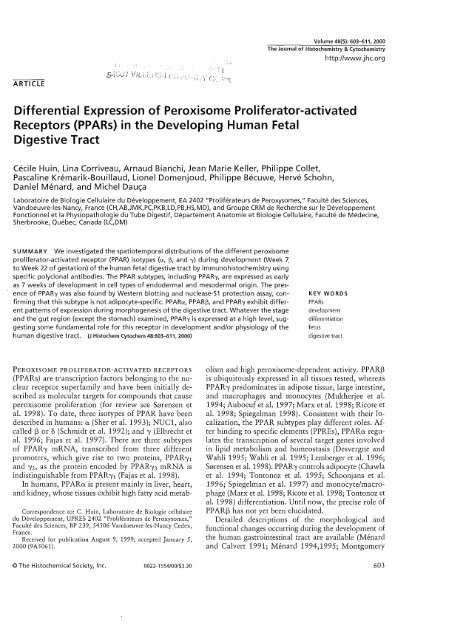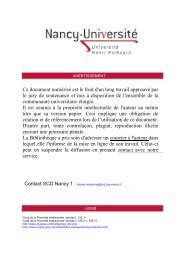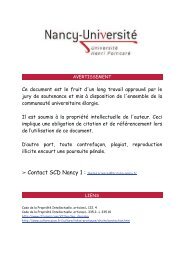Ce document numérisé est le fruit d'un long travail approuvé par le ...
Ce document numérisé est le fruit d'un long travail approuvé par le ...
Ce document numérisé est le fruit d'un long travail approuvé par le ...
You also want an ePaper? Increase the reach of your titles
YUMPU automatically turns print PDFs into web optimized ePapers that Google loves.
Volume 48(5): 603-611, 2000<br />
The Journal of Histochemistry & Cytochemistry<br />
http://www.jhc.org<br />
ARTICLE<br />
" .','<br />
·'·"'.!t<br />
'(<br />
('"'''' . -"<br />
Differentiai Expression of Peroxisome Proliferator-activated<br />
Receptors {PPARs} in the Developing Human Fetal<br />
Dig<strong>est</strong>ive Tract<br />
Céci<strong>le</strong> Huin, Lina Corriveau, Arnaud Bianchi, Jean Marie Kel<strong>le</strong>r, Philippe Col<strong>le</strong>t,<br />
Pascaline Krémarik-Bouillaud, Lionel Domenjoud, Philippe Bécuwe, Hervé Schohn,<br />
Daniel Ménard, and Michel Dauça<br />
Laboratoire de Biologie <strong>Ce</strong>llulaire du Développement, EA 2402 "Proliférateurs de Peroxysomes," Faculté des Sciences,<br />
Vandoeuvre-<strong>le</strong>s-Nancy, France (CH,AB,JMK,PC,PKB,LD,PB,HS,MD), and Groupe CRM de Recherche sur <strong>le</strong> Développement<br />
Fonctionnel et la Physiopathologie du Tube Dig<strong>est</strong>if, Dé<strong>par</strong>tement Anatomie et Biologie <strong>Ce</strong>llulaire, Faculté de Médecine,<br />
Sherbrooke, Québec, Canada (LC,DM)<br />
5 U M MARY We inv<strong>est</strong>igated the spatiotemporal distributions ofthe different peroxisome<br />
proliferator-activated receptor (PPAR) isotypes (a, [3, and -y) during development (Week 7.<br />
to Week 22 of g<strong>est</strong>ation) of the human fetal dig<strong>est</strong>ive tract by immunohistochemistry using<br />
specifie polyclonal antibodies. The PPAR subtypes, including PPAR-y, are expressed as early<br />
as 7 weeks of development in cell types of endodermal and mesodermal origin. The presence<br />
of PPAR-y was also found by W<strong>est</strong>ern blotting and nuc<strong>le</strong>ase-S 1 protection assay, confirming<br />
that this subtype is not adipocyte-specifie. PPARa, PPAR[3, and PPAR-y exhibit different<br />
patterns of expression during morphogenesis of the dig<strong>est</strong>ive tract. Whatever the stage<br />
and thegut region (except the stomach) examined, PPAR-y is expressed at a high <strong>le</strong>vel, sugg<strong>est</strong>ing<br />
some fundamental ro<strong>le</strong> for this receptor in development and/or physiology of the<br />
human dig<strong>est</strong>ive tract. (J Histochem Cytochem 48:603-611, 2000)<br />
KEY WORDS<br />
PPARs<br />
development<br />
differentiation<br />
fetus<br />
dig<strong>est</strong>ive tract<br />
PEROXISOME PROLIFERATOR-ACTIVATED RECEPTORS<br />
(PPARs) are transcription factors be<strong>long</strong>ing to the nuc<strong>le</strong>ar<br />
receptor superfamily and have been initiaUy described<br />
as ~o<strong>le</strong>cular targets for compounds that cause<br />
peroxisome proliferation (for review see S0rensen et<br />
al. 1998). To date, three isotypes of PPAR have been<br />
described in humans: œ (Sher et al. 1993); NUC1, also<br />
caUed [3 or 0 (Schmidt et al. 1992); and 'Y (Elbrecht et<br />
al. 1996; Fajas et al. 1997). There are three subtypes<br />
of PPAR"I mRNA, transcribed from three different<br />
promoters, which give rise to two proteins, ppAR"11<br />
and "12, as the protein encoded by PPAR"I3 mRNA is<br />
indistinguishab<strong>le</strong> from PPAR"Il (Fajas et al. 1998).<br />
In humans, PPARœ is present mainly in liver, heart,<br />
and kidney, whose tissues exhibit high fatty acid metab-<br />
Correspondence to: C. Huin, Laboratoire de Biologie cellulaire<br />
du Développement, UPRES 2402 "Proliférateurs de Peroxysomes,"<br />
Faculté des Sciences, BP 239, 54506 Vandoeuvre-<strong>le</strong>s-Nancy <strong>Ce</strong>dex,<br />
France.<br />
Received for publication August 9, 1999; accepted ]anuary 5,<br />
2000 (9A5061).<br />
olism and high peroxisome-dependent activity. PPAR[3<br />
is ubiquitously expressed in aU tissues t<strong>est</strong>ed, whereas<br />
ppAR'Y predominates in adipose tissue, large int<strong>est</strong>ine,<br />
and macrophages and monocytes (Mukherjee et al.<br />
1994; Auboeuf et al. 1997; Marx et al. 1998; Ricote et<br />
al. 1998; Spiegelman 1998). Consistent with their 10<br />
calization, the PPAR subtypes play different ro<strong>le</strong>s. After<br />
binding to specifie e<strong>le</strong>ments (PPREs), PPARœ regulates<br />
the transcription of several target genes involved<br />
in lipid metabolism and homeostasis (Desvergne and<br />
Wahli 1995; Wahli et al. 1995; Lemberger et al. 1996;<br />
S0fensen et al. 1998). PPAR"I controls adipocyte (Chawla<br />
et al. 1994; Tontonoz et al. 1995; Schoonjans et al.<br />
1996; Spiegelman et al. 1997) and monocyte/macrophage<br />
(Marx et al. 1998; Ricote et al. 1998; Tontonoz et<br />
al. 1998) differentiation. Until now, the precise ro<strong>le</strong> of<br />
ppAR[3 has not yet been elucidated.<br />
Detai<strong>le</strong>d descriptions of the morphological and<br />
functional changes occurring during the development of<br />
the human gastroint<strong>est</strong>inal tract are availab<strong>le</strong> (Ménard<br />
and Calvert 1991; Ménard 1994,1995; Montgomery<br />
© The Histochemical Society, Ine. 0022-1554/00/$3,30 603
















